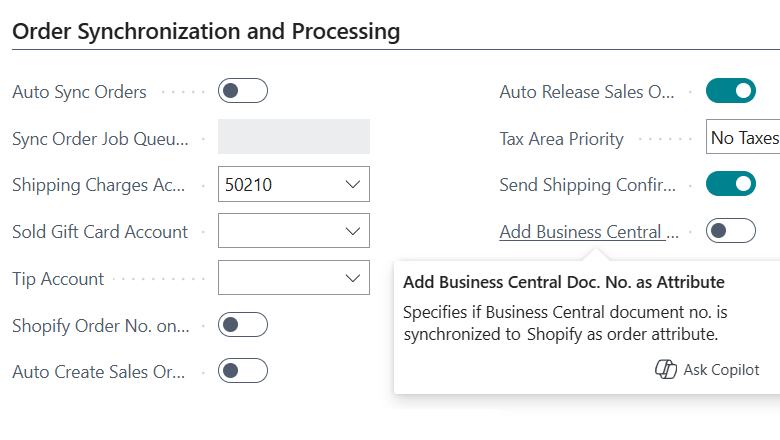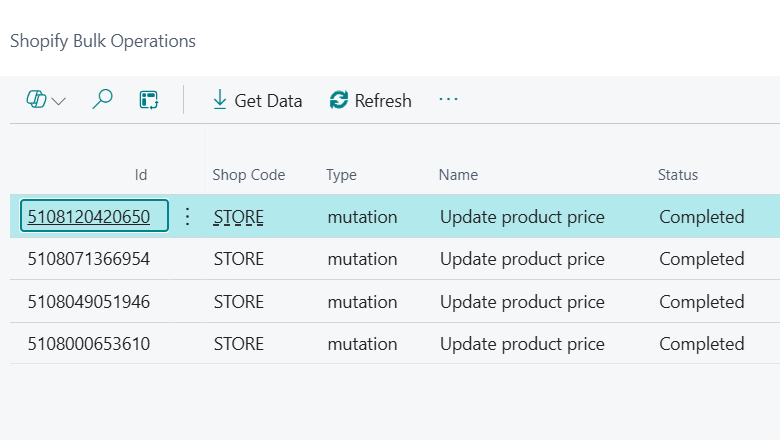 This post is part of the New Functionality In Microsoft Dynamics 365 Business Central 2025 Wave 1 series in which I am taking a look at the new functionality introduced in Microsoft Dynamics 365 Business Central 2025 Wave 1.
This post is part of the New Functionality In Microsoft Dynamics 365 Business Central 2025 Wave 1 series in which I am taking a look at the new functionality introduced in Microsoft Dynamics 365 Business Central 2025 Wave 1.
The 16th of the new functionality in the E-commerce section is use the latest update for the Shopify connector.
The latest update for the Shopify connector includes changes from Shopify, such as bulk variant handling and new product information management. In addition, Microsoft have added multiple enhancements based on feedback from Microsoft’s community.
Enabled for: Users by admins, makers, or analysts
Public Preview: –
General Availability: Apr 2025
Feature Details
Shopify releases a new API version every three months at the beginning of the quarter, and supports each version for 12 months. The updated versions might contain important changes, so it’s important to uptake Shopify API versions in major releases of Business Central. Typically, new versions of APIs increase stability and security, and enable additional capabilities. Starting with this release, the Shopify connector uses the Shopify API that was released in January 2025.
 Important
Important
The Shopify connector released in 2024 release wave 2 (October 2024) relies on API 2024-07, which is supported until July 1, 2025. To continue to use your integration, upgrade to the latest version of Business Central before this date.
Bulk updates of product variants
Shopify deprecated singular product variants in favor of their equivalent bulk versions. Now, the Shopify connector creates or updates variants in bulk. That change improves overall performance of the connector because hundreds of updates happen in a single call. This change affects the initial creation of products with variants or scheduled updates of Shopify products and variants.
Handling the Price Including Tax setting
Starting with this release, the Price Including VAT toggle in the Shopify Shop Card page no longer affects the creation of sales documents. The information about whether prices include tax comes directly from Shopify, which is useful when selling to different markets using the Include or exclude tax based on your customer’s country setting in Shopify Admin.
 Important
Important
For merchants using the US or Canadian localizations, select [b]Include sales tax in product price and shipping rate[/b] in Shopify Admin. If enabled, you can’t convert imported orders into sales documents because Business Central doesn’t support backward sales tax calculation.
If this field is selected and you don’t charge taxes, you can manually turn off the [b]VAT (Tax) Included[/b] field in the [b]Shopify Order[/b] page and proceed.
To simplify troubleshooting, you can inspect tax lines from the Shopify Order page.
More capabilities for filtering orders
Order synchronization now supports the Ship-to, Bill-to, and Sell-to Countries, and Tax Amount filters. The filters are useful for merchants in the European Union who sell to B2B customers in other EU member states and where, because of reverse charges, the order doesn’t include VAT.
To learn more about rules like this, go to Different processing rules for orders.
Sorting in the Shopify Orders to Import page
The Shopify Orders to Import page now shows the newest orders on top.
The page is useful for troubleshooting issues with order imports. You can assess the orders that are available, and take the next steps:
- Check whether an error blocked the import of a specific order, and explore the error’s details. Select the Has Error field.
- Process only specific orders. Fill in the Shop Code field, select one or more orders, and then choose the Import Selected Orders action.
- Delete orders from the Shopify Orders to Import page to exclude them from the sync.
Deprecation of REST resources
Shopify continues its transition from REST to GraphQL, and in this release they deprecated endpoints on the Country and Province resources. The Shopify connector uses that information to fill in the Shopify Customer Templates page with a list of countries where shipping is allowed. This feature still works because the Shopify connector gets this information from the properties of the shop.
Shopify can’t receive the list of associated provinces. The list of provinces is included in the Shopify connector as setup data. There are several countries that require a province code to validate address information. Because Business Central doesn’t enforce the use of the Country field or validate the content, the Shopify connector uses the County Code field in the Shopify Shop Card together with Shopify Tax Area page to get a province code when you create a customer or company in Shopify.
Shopify requires a state/province for the following countries:
- United Arab Emirates
- Argentina
- Australia
- Brazil
- Canada
- Chile
- China
- Colombia
- Costa Rica
- Egypt
- Spain
- United Kingdom
- Guatemala
- Hong Kong SAR
- Indonesia
- Ireland
- India
- Italy
- Japan
- South Korea
- Kuwait
- Mexico
- Malaysia
- Nigeria
- Panama
- Peru
- Philippines
- Portugal
- Romania
- Russia
- El Salvador
- Thailand
- United States
- Uruguay
- Venezuela
- South Africa
 Note
Note
Great Britain has provinces, but a province isn’t mandatory for addresses.
Other improvements
Microsoft have also implemented a number of improvements that aren’t related to the new API version, but that improve the general usability of the connector.
After you import a Shopify order to Business Central, you can automatically or manually create a sales document. You can create a sales invoice if the Shopify order is already fulfilled, or a sales order if you handle fulfillment in Business Central. When you create a sales document, the document number synchronizes to Shopify as an order attribute.
It can be useful for people who work with Shopify Admin to see whether orders synchronized to Business Central. In some cases, for example in high load environments, you might want to turn off synchronization. The new Add Business Central Doc. No. as Attribute toggle gives you control over synchronization.
The previous release offered a new way to deal with risk assessments. Shopify now supports two levels and external providers. The connector continues to import both risk and sentiments. However, there wasn’t a single value that represents the risk associated with an order. To address that gap, Microsoft are adding a High Risk field to the Shopify Order and Sync Orders from Shopify request pages. The field is Boolean, and is enabled when an order is assessed as high risk.
The Request Data, Response Data on the Shopify Log Entry page, and Json Data in the Shopify Data Capture List now use a rich text control that displays more information. As a result, it simplifies troubleshooting.
The Create Shopify Fulfilment Service action is now also on the Shopify Locations page, so you can create fulfillment service locations when you map locations.
Changes that became mandatory
The Enable using bulk operations for Shopify connector feature is now mandatory and you can’t disable it. The feature affects price synchronization, so that prices synchronize in bulk.
You can check the status of the synchronization in the Shopify Bulk Operations page.
Click to show/hide the New Functionality In Microsoft Dynamics 365 Business Central 2025 Wave 1 Series Index
What should we write about next?
If there is a topic which fits the typical ones of this site, which you would like to see me write about, please use the form, below, to submit your idea.








